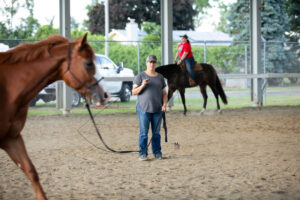Circling Back to Joint Health in Horses
Regardless of discipline, young horses in training frequently work in circles, either on longe or long lines, under saddle, or in round pens. During these exercises, horses typically lean into the center of the circle to maintain balance. As a result, the strains placed on the inside limbs are different from those withstood by the outside limbs. Uneven forces on joints and bones may lead to a higher rate of injury and precipitate the development of osteoarthritis.
“Osteoarthritis is a leading cause of lameness and loss of function in athletic horses. Currently, there is no cure for osteoarthritis. Instead, owners and veterinarians manage discomfort with symptom-modifying drugs, such as corticosteroids and anti-inflammatories, and oral joint health supplements,” said Katie Young, Ph.D., a nutritionist for Kentucky Equine Research.
Considering how commonly young horses are asked to work in circles, researchers recently examined whether this type of exercise leads to asymmetry of the forelimbs. In addition, markers of cartilage metabolism were also assessed.*
Calves have been used in previous studies as skeletal models of juvenile horses, so this study used 24 nine-week-old calves. Calves were exercised in small 12-meter circles, larger 20-meter circles, or on a straight line on a treadmill. The calves ambulated slowly, walking at a rate of only 1.1-1.5 meters/second, starting at five minutes per day and increasing five minutes weekly until reaching 30 minutes per day over the seven-week study.
After 49 days, the forelegs of the calves were subjected to computed tomography (CT). These scans revealed that the outside forelegs had a greater diameter than the inside forelegs when the calves were walked in small circles.
“This increased diameter represents bone adaptation to stress placed on the limbs while exercising in a circle. The difference in diameters supports the theory that exercising in small circles results in uneven stresses on the inside versus outside of the limbs,” explained Young.
In addition, the veterinary research team found an increased level of metabolism, or turnover, in cartilage harvested from the outside forelegs of calves exercised in small circles.
“Therefore, even at slow speeds, circular exercise can negatively affect bone and joint health. These changes may be even more pronounced at higher speeds and workloads, such as those experienced by young horses in training,” Young said.
These findings suggest that frequent circular exercise of young horses may lead to bone and joint abnormalities that can affect the horse’s long-term health and soundness. Horse owners should consider circle size and speed of travel when working young horses in circles. These data may also prompt additional research into the best type of work for training horses. Specifically, altering circle size and speed during training may lead to improved joint and bone health over the long haul.
In addition, the practice of prophylactically administering oral joint health supplements may benefit young animals prior to joint trauma and inflammation. Oral joint health supplements containing glucosamine, chondroitin sulfate, and hyaluronic acid, such as those offered by Kentucky Equine Research, may be helpful in supporting horses at risk of osteoarthritis.
According to Young, “Studies show that these ingredients help decrease inflammation through multiple pathways and may provide molecular precursors to cartilage cells to support building new, healthy cartilage in arthritic joints.”
When choosing oral joint health supplements for horses, be certain to choose quality nutritional supplements, as not all products are manufactured in accordance with sound manufacturing practices. As a result, contaminated products that do not contain the type or amount of ingredient that is listed on the label abound and are of no benefit to horses suffering from or at risk of osteoarthritis.
*Logan, A.A., B.D. Nielsen, K.M. Hiney, C.I. Robison, J.M. Manfredi, D.D. Buskirk, and J.M. Popovich. 2022. The impact of circular exercise diameter on bone and joint health of juvenile animals. Animals (Basel) 12(11):1379.











